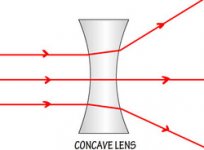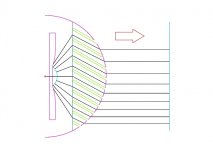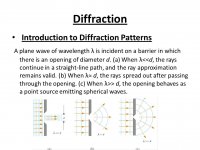Same wave physics!Different reality perception & organization
If I'm reading it correctly, the narrowed vertical dispersion would prevent treble energy being wasted through being directed towards the ceiling or the floor.
So we only have PA efficiency? 🙁
More concerned about the interference of mids and twitter around the xover frequency and all the related deffects.
- could a more straightforward vertical dispersion reduce the interference with the mids dispersion? (the driver mounted bellow)
It is also interesting what is the efect of the more wide / uniform lateral dispersion to the stereo imaging.
// all the above about the JBL type slanted acoustic 'lens'.
Last edited:
I assume that an acoustic lens does what it does with the help of diffraction.
Diffraction is not a good idea and should be avoided.
Which is probably why you don't see them much anymore.
Diffraction is not a good idea and should be avoided.
Which is probably why you don't see them much anymore.
The papers in the link below agree with the wider dispersion mentioned by JMFahey.
Horns are very directional at high frequencies, and an acoustic lens widens the dispersion when used in conjunction with a horn rather than with a point source such as a dome tweeter.
Doesn't give an answer to your questions though!
Acoustic Lens Technology – the research continues | Evangel Ric Lapore
Horns are very directional at high frequencies, and an acoustic lens widens the dispersion when used in conjunction with a horn rather than with a point source such as a dome tweeter.
Doesn't give an answer to your questions though!
Acoustic Lens Technology – the research continues | Evangel Ric Lapore
Last edited:
Not diffraction Charles, but refraction. Check out the papers in my previous post.I assume that an acoustic lens does what it does with the help of diffraction.
The slanted plate style acoustic lens only works in the horizontal direction.If I'm reading it correctly, the narrowed vertical dispersion would prevent treble energy being wasted through being directed towards the ceiling or the floor.
Here is some background information: https://www.tnt-audio.com/clinica/acoustic_lens.pdf
Last edited:
It is either reflection or diffraction, or probably both...
Refraction is more related to optics - going from a medium to a medum. f.ex. glass to air, water to air and vice versa.
It closer resembles a transparent optics lens.
- Reflection, Refraction, and Diffraction
Anyway, have to find a guideline on how to design this JBL type of lens.
Then I can decide.
Not a problem to make the parts from acrylic or HPL.
But how to design this?
p.p. I found an article praising the slanted lens design. Says it is "the best" solution for HF.
At the end, it says it is not seen nowadays, mostly because of how it looks 😀.
But cant find the exact same article
Refraction is more related to optics - going from a medium to a medum. f.ex. glass to air, water to air and vice versa.
It closer resembles a transparent optics lens.
- Reflection, Refraction, and Diffraction
Anyway, have to find a guideline on how to design this JBL type of lens.
Then I can decide.
Not a problem to make the parts from acrylic or HPL.
But how to design this?
p.p. I found an article praising the slanted lens design. Says it is "the best" solution for HF.
At the end, it says it is not seen nowadays, mostly because of how it looks 😀.
But cant find the exact same article
Last edited:
The slanted plate style acoustic lens only works in the horizontal direction.
What about the vertical dispersion diagram from the JBL paper?
It shows kind a narrowing the 'beam' in a vertical crossection.
Not really parallel, but..
It is most definitely refraction.It is either reflection or diffraction, or probably both...
Refraction is more related to optics - going from a medium to a medum. f.ex. glass to air, water to air and vice versa.
It closer resembles a transparent optics lens.
Refraction relates to the change in speed when a wave travels from one medium into another.
Just as light slows down when it enters glass, sound waves slow down when they enter an acoustic lens. See my earlier link for the full explanation.
P.S. My link gives the same paper as TBTL's link.
Last edited:
Yes, you were correct in relation to the use of an acoustic lens on a treble horn. Rather than is the case with a point source however, the wavefronts emerge parallel from the horn mouth as the horn is directional at high frequencies.These lenses have a similar shape to a negative optic lens. If they are mounted to a horn (= point source located at the compression driver), I expect them to widen the dispersion.
To agree with the scholarly papers, the attached diagram showing how a concave lens diverges light would be the correct illustration to show how an acoustic lens gives a wider dispersion from a horn.
Attachments
it is actually used with a weird metal ribbon tweeter, used for 100 db + horrible techno music. they sound OK at normal volume but the design is a real PA application, I would not use it at home at all.
this looks similar but it is an assembly:
Speakers | ESS Laboratories, LLC
AMT Limited Edition , I heard them a long time ago..
They aren't typical sounding speakers, they are not hifi souding, not very refined, but they do play classical music and DANCE music, they are very much party speakers with a twist, clear good sound.
Pretty impressive and amazing speakers, close to your idea but cleverly integrated 'blinds' in the ribbon tweeter
Speakers | ESS Laboratories, LLC
AMT Limited Edition , I heard them a long time ago..
They aren't typical sounding speakers, they are not hifi souding, not very refined, but they do play classical music and DANCE music, they are very much party speakers with a twist, clear good sound.
Pretty impressive and amazing speakers, close to your idea but cleverly integrated 'blinds' in the ribbon tweeter
Problem is, you don´t have a point source AT ALL.The spherical wavefronts from the point sound are diverging outwards and this would result in wide dispersion.
This acoustic lens was designed and used specifically at the front of horns, as directional a source as can be, and they wanted to correct that.
No, this acoustic lens is not a convergent one as you wrongly show in your diagram but a divergent one.The acoustic lens converts the diverging wavefronts into parallel wavefronts which results in a more controlled and uniform dispersion.
A convergent lens narrows a beam, from whatever angle it has to, hopefully, parallel lines, what you show in your drawing, the opposite to what´s needed; while a divergent lens widens the angle, improving coverage among the audience.
The vertical dispersion is already narrow, coming from a horn.Isn't it the case, as emosms has just said, that the acoustic lens gives a uniform horizontal dispersion while narrowing the vertical dispersion?
Isn't this dispersion pattern extremely useful in PA for proper audience coverage of high fequencies?
In any case, acoustic lenses try to widen horizontal duspersion, that´s whereb the audience is.
Not what you are showing, that´s not a uniform dispersion/coverage but a narrowly focused one, covering a narrow section of audience, again the opposite of what's needed.
Maybe some do not know how this lens works, and pick the wrong type optical lens analogy.
How it works?
* an optical lens works because we have refraction, and light speed in that media is different than lightspeed in vacuum and that is expressed by the refraction index.
* an acoustical lens works the exact same way 😱
In this case we can not change sound speed so we change the sound path... end result ends up being the same.
The sheets making the vanes or blinds are not flat but are stamped in a zigagging shape so path is longer than in free air.
Making path 40% longer is same as glass having a refraction index of 1.4 😱
Now look at the typical lens from above: sound on axis has the shortest path, the shortest delay.
As you look left and right, effective path is longer, having more travel through vanes is equivalent to light travelling tnhrough thicker glass.
So thetypical acoustic lens is equivalent bto an optical divergent/convex glass, thinner in center, thicker towards the edges ... the exact opposite of your drawing ... and the exact opposite effect, it will widen the dispersion instead of focusing it in a parallel path (what you show).
Hope this clears what acoustic lenses do. 🙂
Pls, let me clarify a particular case. Let's focus on the VERTICAL dispersion for now.
I have the following Loudspeaker (attached picture).
- 1'' textile dome tweeter
- 10'' whizzer cone midbas
- 350 mm c-c distance between Tweeter and MIdbas (don't ask why - it looks good 😀 )
- 5 kHz Xover frequency
- ~ 2,5/3m to listening position
If I could control the vertical dispersion with a slanted wave guide:
- would I want to narrow it, in order to get better coherency between HF and Mids ?
According to the Xover frequency, the wavelength for 5kHz is 68 mm.
Distance between Mid and HF driver should be 1 wavelength max. 1/2 wavelength - even better....
My spacing is ~ 5 times larger.

I also apply my understanding of the slanted acoustic lens (attached picture).
If we form a convex shape with the slanted boards - we are supposed to narrow the soundwaves beam?

This is a vertical section
I have the following Loudspeaker (attached picture).
- 1'' textile dome tweeter
- 10'' whizzer cone midbas
- 350 mm c-c distance between Tweeter and MIdbas (don't ask why - it looks good 😀 )
- 5 kHz Xover frequency
- ~ 2,5/3m to listening position
If I could control the vertical dispersion with a slanted wave guide:
- would I want to narrow it, in order to get better coherency between HF and Mids ?
According to the Xover frequency, the wavelength for 5kHz is 68 mm.
Distance between Mid and HF driver should be 1 wavelength max. 1/2 wavelength - even better....
My spacing is ~ 5 times larger.

I also apply my understanding of the slanted acoustic lens (attached picture).
If we form a convex shape with the slanted boards - we are supposed to narrow the soundwaves beam?

This is a vertical section
Last edited:
Thanks for your input JM.Problem is, you don´t have a point source AT ALL.
This acoustic lens was designed and used specifically at the front of horns, as directional a source as can be, and they wanted to correct that.
I started off looking at a point source. However, on further thought, I changed my narrative away from point sources to directional sources (such as horns) in posts #24 and #31.
In those posts I already made the corrections you now make. 😎
Thank you for your explanation of how the slant plate version of the acoustical lens works.
I see now that I mistakenly referred to the 'obstacle array' type acoustical lens rather than the 'path-length' type which you describe. The reference https://www.tnt-audio.com/clinica/acoustic_lens.pdf describes the former as decreasing the velocity of sound while the latter increases the path length.
My optical lens analogy works for the former, but not for the latter!
Learning all the time! 🙂
@ emosms
As per my original discussion, you are suggesting converting sound from a point source into a planar wavefront.
At high frequencies, this can be done by use of a path length refractor which acts like a convex or converging lens as shown in your diagram.
I agree with your thinking that this will produce a narrow vertical pattern.
As per my original discussion, you are suggesting converting sound from a point source into a planar wavefront.
At high frequencies, this can be done by use of a path length refractor which acts like a convex or converging lens as shown in your diagram.
I agree with your thinking that this will produce a narrow vertical pattern.
Attachments
Not diffraction Charles, but refraction. Check out the papers in my previous post.
Given that diffraction happens even at cabinet corners I can't see how it could NOT be a major part of the workings of an acoustic lens like one posted by the OP.
wiki tells us that for acoustic refraction to occur the sound has to travel through a medium of inhomogeneous density which it doesn't with the acoustic lens.
I find comparisons to light not particularly helpful in this case.
Hi Charles! Hope I don't appear to be combative if I quote the physics as I see it. Please feel free to mark my homework! 🙂I find comparisons to light not particularly helpful in this case.
Both types of acoustical lens ('obstacle array' & 'path length refractor' - note the use of the word 'refractor' there!) bend light in an analagous fashion to the bending caused by refraction in an optical lens. I, and the learned papers, find the comparisons to light very useful even though the mechanisms involved are not the same.
Regarding diffraction, you will be aware that the degree of bending depends on wavelength (for those unfamiliar, see attached diagrams). When the wavelength is smaller than the width of the opening there is minimum diffraction.
In a tweeter, the plate spacing of the acoustical lens is optimised for the range of high frequencies (short wavelengths) over which it operates and the diffraction effect is minimal. Longer wavelengths, if allowed to pass through the same lens would be diffracted considerably, and this may be the effect to which you refer.
Rather than utilise diffraction, the plates force the sound to travel a greater distance than it would otherwise.
P.S. Regarding the 'medium of inhomogeneous density', refer to the workings of the 'obstacle array' type acoustical lens where I think the term qualifies.
Attachments
It is not so much about utilizing diffraction but how to avoid it.
The sound wave will diffract at every edge of the lens the same way it unfortunately occurs at sharp cabinet corners.
Even at 20k the wavelength is larger than the gap the sound squeezes through in one of those lenses so diffraction will occur.
Re your PS I don't think it does as the sound would have to travel within the metal parts.
It is only mentioned on wiki as to be happening within the atmosphere if there are areas of higher and lower pressure ie temperature. Same goes for sound travelling under water.
The sound wave will diffract at every edge of the lens the same way it unfortunately occurs at sharp cabinet corners.
Even at 20k the wavelength is larger than the gap the sound squeezes through in one of those lenses so diffraction will occur.
Re your PS I don't think it does as the sound would have to travel within the metal parts.
It is only mentioned on wiki as to be happening within the atmosphere if there are areas of higher and lower pressure ie temperature. Same goes for sound travelling under water.
- Status
- Not open for further replies.
- Home
- Loudspeakers
- Multi-Way
- tweeter with blinds-like waveguide


